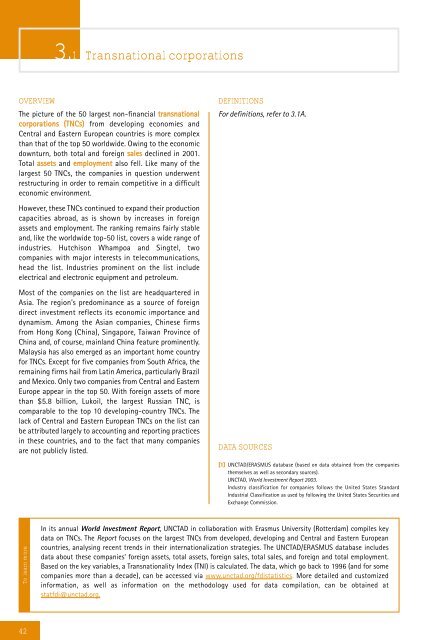Development and Globalization: - Unctad
Development and Globalization: - Unctad
Development and Globalization: - Unctad
Create successful ePaper yourself
Turn your PDF publications into a flip-book with our unique Google optimized e-Paper software.
OVERVIEW DEFINITIONS<br />
The picture of the 50 largest non-financial transnational<br />
corporations (TNCs) from developing economies <strong>and</strong><br />
Central <strong>and</strong> Eastern European countries is more complex<br />
than that of the top 50 worldwide. Owing to the economic<br />
downturn, both total <strong>and</strong> foreign sales declined in 2001.<br />
Total assets <strong>and</strong> employment also fell. Like many of the<br />
largest 50 TNCs, the companies in question underwent<br />
restructuring in order to remain competitive in a difficult<br />
economic environment.<br />
However, these TNCs continued to exp<strong>and</strong> their production<br />
capacities abroad, as is shown by increases in foreign<br />
assets <strong>and</strong> employment. The ranking remains fairly stable<br />
<strong>and</strong>, like the worldwide top-50 list, covers a wide range of<br />
industries. Hutchison Whampoa <strong>and</strong> Singtel, two<br />
companies with major interests in telecommunications,<br />
head the list. Industries prominent on the list include<br />
electrical <strong>and</strong> electronic equipment <strong>and</strong> petroleum.<br />
Most of the companies on the list are headquartered in<br />
Asia. The region’s predominance as a source of foreign<br />
direct investment reflects its economic importance <strong>and</strong><br />
dynamism. Among the Asian companies, Chinese firms<br />
from Hong Kong (China), Singapore, Taiwan Province of<br />
China <strong>and</strong>, of course, mainl<strong>and</strong> China feature prominently.<br />
Malaysia has also emerged as an important home country<br />
for TNCs. Except for five companies from South Africa, the<br />
remaining firms hail from Latin America, particularly Brazil<br />
<strong>and</strong> Mexico. Only two companies from Central <strong>and</strong> Eastern<br />
Europe appear in the top 50. With foreign assets of more<br />
than $5.8 billion, Lukoil, the largest Russian TNC, is<br />
comparable to the top 10 developing-country TNCs. The<br />
lack of Central <strong>and</strong> Eastern European TNCs on the list can<br />
be attributed largely to accounting <strong>and</strong> reporting practices<br />
in these countries, <strong>and</strong> to the fact that many companies<br />
are not publicly listed.<br />
To learn more<br />
42<br />
3.1 Transnational corporations<br />
For definitions, refer to 3.1A.<br />
DATA SOURCES<br />
[1] UNCTAD/ERASMUS database (based on data obtained from the companies<br />
themselves as well as secondary sources).<br />
UNCTAD, World Investment Report 2003.<br />
Industry classification for companies follows the United States St<strong>and</strong>ard<br />
Industrial Classification as used by following the United States Securities <strong>and</strong><br />
Exchange Commission.<br />
In its annual World Investment Report, UNCTAD in collaboration with Erasmus University (Rotterdam) compiles key<br />
data on TNCs. The Report focuses on the largest TNCs from developed, developing <strong>and</strong> Central <strong>and</strong> Eastern European<br />
countries, analysing recent trends in their internationalization strategies. The UNCTAD/ERASMUS database includes<br />
data about these companies’ foreign assets, total assets, foreign sales, total sales, <strong>and</strong> foreign <strong>and</strong> total employment.<br />
Based on the key variables, a Transnationality Index (TNI) is calculated. The data, which go back to 1996 (<strong>and</strong> for some<br />
companies more than a decade), can be accessed via www.unctad.org/fdistatistics. More detailed <strong>and</strong> customized<br />
information, as well as information on the methodology used for data compilation, can be obtained at<br />
statfdi@unctad.org.

















